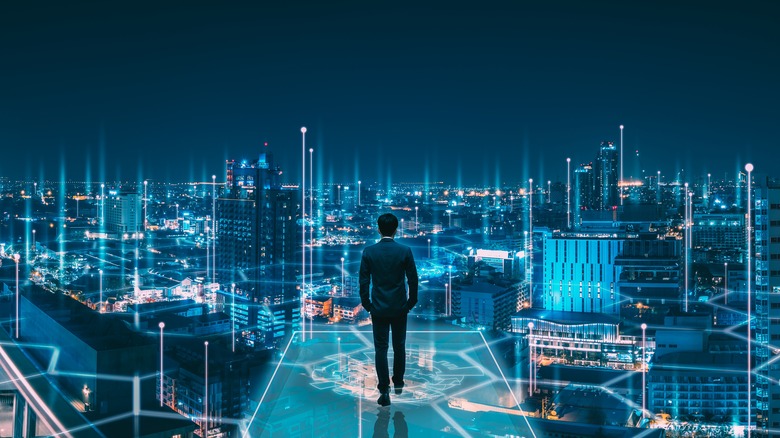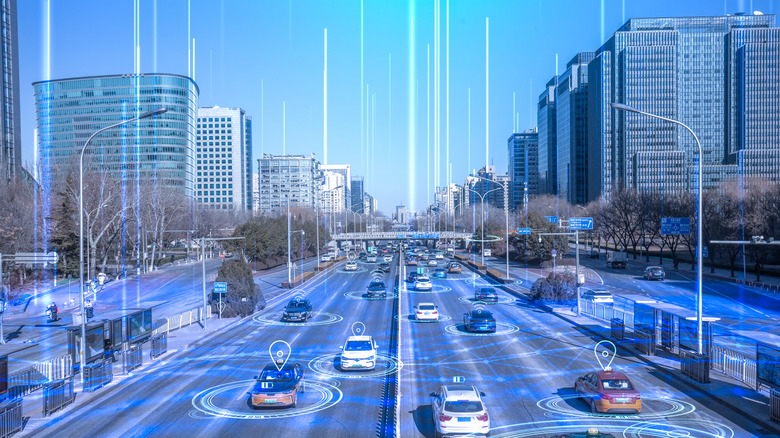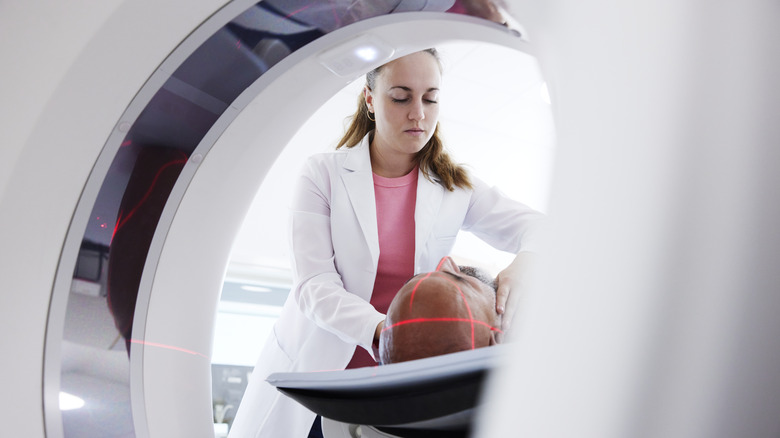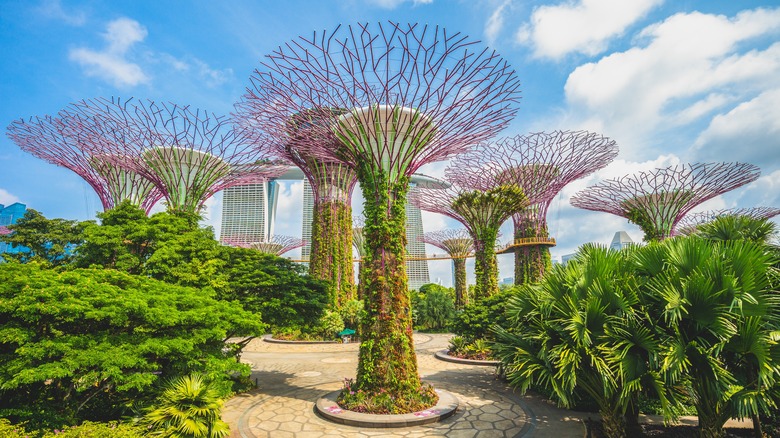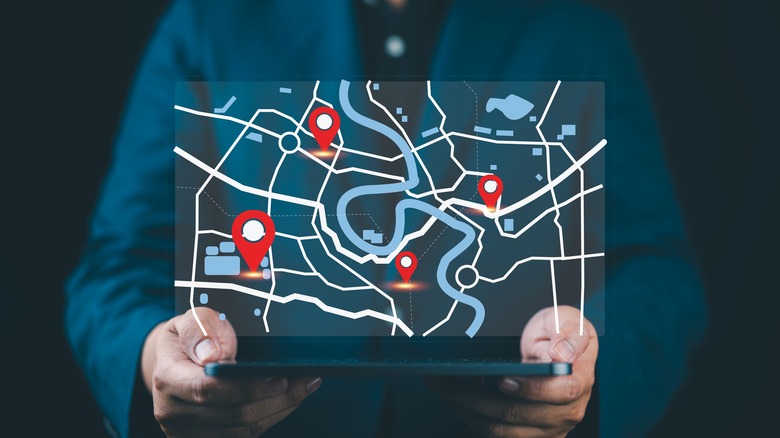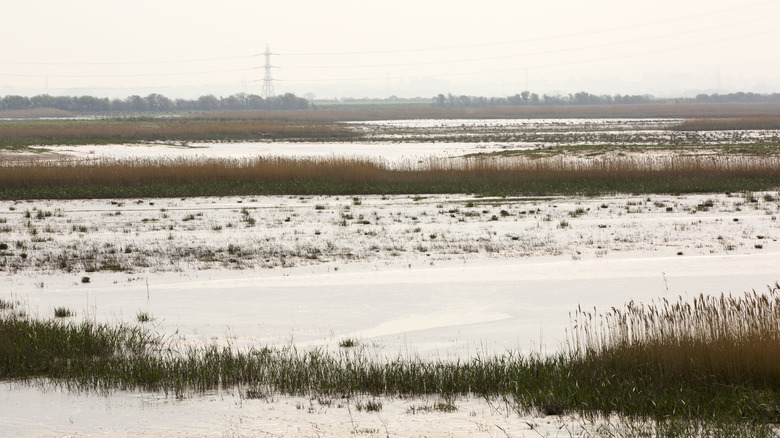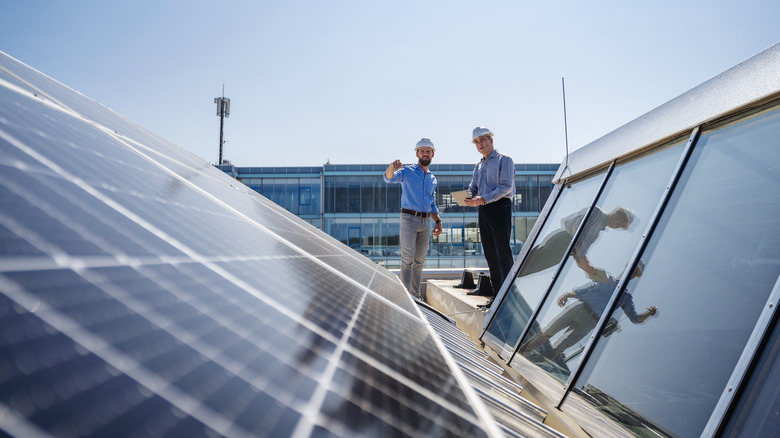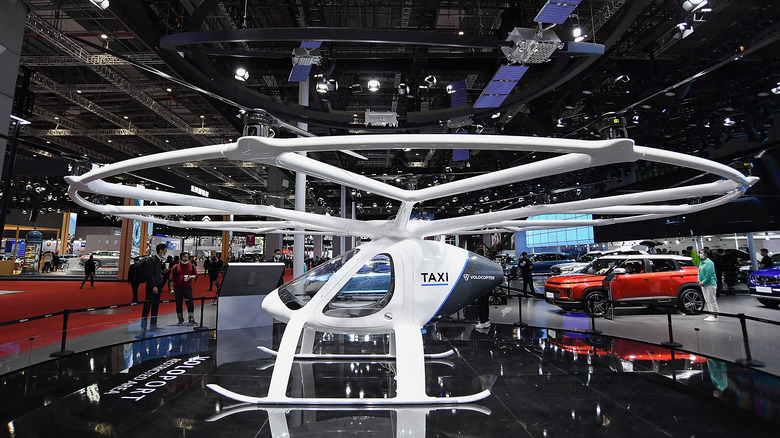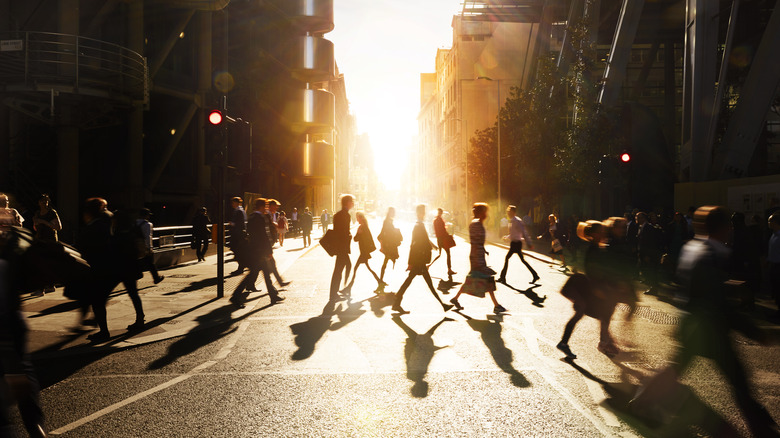10 Futuristic Concepts That Are Already Shaping Smart Cities
The concrete jungle of New York City, sprawling suburbs of Greater London, and massive bike culture in Copenhagen share a key feature that links them and many other global communities. It's not the dense city life or a strong sense of architectural self. Instead, these smart cities use big data insights and a plethora of other innovative and futuristic design concepts to advance the lifestyle that their residents enjoy.
Places like San Francisco and London feature integrated traffic management and parking efficiency solutions, while Singapore, Oslo, and Barcelona all share a desire to improve air quality, bring in green infrastructure, and prioritize sustainability. Nearly everyone has seen the flying cars, communication doodads, and data analysis tools that feel almost magical in sci-fi flicks that have hit the silver screen throughout the years. The HAL system in 1968's "2001: A Space Odyssey" is a rogue AI tool meant to support the astronauts onboard its station, while 2002's "Minority Report" pairs a kind of psychic vision with virtually indiscriminate surveillance coverage to stop crime before it happens. Many advancements come in dystopian fiction, but there's nothing sinister about modern, real-life cities improving the energy efficiency of their communities, exploring new renewable options, or dabbling with new transportation methods that make residents and visitors feel more comfortable and capable. These and other futuristic concepts are already making their way into smart cities around the world and are sure to continue finding prominence in ongoing developments everywhere.
The Internet of Things (IoT)
The Internet of Things (IoT) is a somewhat novel framework for exploring our surroundings. It involves connecting an array of tools to the internet so they can interact with one another and share information without delays or complications. Traditionally, to gain information for central decision-making, a government or business would need to invest time, energy, and resources into data collection. People would explore the community to identify needs and then report back to create a plan. Sometimes, individuals may have the authority to perform routine tasks (like a garbage collector identifying and emptying full trash cans), while in other cases, this might not be feasible — such as in studies of roadway congestion aimed at shortening commutes.
IoT technology shifts the burden of data collection, analysis, and even some actions away from traditional, slower processes. Instead of sending out engineers to monitor intersections, a connected system can collect all the necessary data and compile it in a database. IoT-enabled urban lighting systems, for example, can turn on or off as needed. Connecting everyday items and urban systems to the internet allows them to be remotely accessed, providing real-time information through a network of sensors, cameras, and other measurement and analytical tools. This helps decision-makers improve their cities in countless ways without needing long studies or diverting human resources from other important projects. IoT is a baseline feature in smart cities, forming the foundation for nearly every technological concept that will impact future urban infrastructure.
Technically advanced, community-centric health services
Human history has been a grand story of innovation, specialization, and cooperative collaboration. From early farming and crafting to today's technology-driven productivity, none of this progress would be possible without humanity's collective drive to work together in community networks. One area where immense progress has been made is health care. Early health services involved herbs and quasi-mystical practices that often relied on scientific phenomena we can now explain. Today, about 40% of pharmaceutical products draw from traditional knowledge and natural phenomena.
Contemporary health care often follows a model of frontline clinicians and second-line specialist care. You visit your doctor when sick or injured, and if you require anything beyond basic treatment, you're referred to a larger medical facility with specialized professionals. CT scans, surgical procedures, and even treatments for key bodily areas like the eyes require additional specialists. However, smart cities are flipping the script on this type of treatment. There's no reason an X-ray (a technology among the most impactful advancements in the health care industry) can't be performed in your local doctor's office beyond a simple lack of equipment. Contemporary smart cities are integrating highly technical health services right into the fabric of communities, rather than building specialized care hubs. In the U.K., these facilities are being planned as inclusions in shopping centers and other common public areas, with the goal of eliminating the need to go to the hospital and wait for hours or even days to receive necessary care.
Green urban planning
Urban planning has always been a core part of citywide improvement. Urban areas everywhere build in sprawling, rapid cycles. As populations grow in cities around the world – today, 56% of the global population lives in cities, with an estimated figure of roughly 70% by 2050 — smarter design will be essential. High-density living often appears chaotic and post-apocalyptic in fictional visions of the future. Citizens packed into increasingly tighter living quarters and dealing with strained community resources is a common trope used to initiate action in movies, television, and written explorations of the future. But in the present day, urbanization doesn't have to take on this role of stifling constriction.
Cities like Singapore, Athens, and Boston are reimagining what urban density can look like with green urban planning initiatives. Singapore is one of the most prominent global examples. The city-state's Gardens by the Bay merges architecture and plant structures to showcase "Supertrees" that generate solar power, harvest rainwater, provide shade, and more. Green inclusions lower the ambient temperature of urban landscapes that are heavy on heat-accumulating concrete (among other materials) and significantly improve air quality and overall mental health for people living there. With more bodies expected to take up urban residential space in the years ahead, green initiatives aren't just a nice touch that adds color and contrast but a feature that will necessarily support healthy living.
Utilizing geolocation data for improved urban planning and resource allocation
A part of the progression toward integrated Internet of Things technology, geodata is a hybrid information resource that pairs the subject of study with its specific location. Geographic information system (GIS) is not a new approach to analyzing city planning needs or exploring complex global challenges, but it has seen expanded use in today's technically advanced urban planning strategies. Geolocation information can be as simple as a plug-in that brings back geographically relevant results when you search on Google Maps (after all, a hardware store or McDonald's in Seattle isn't helpful to a person standing in Milwaukee, although faking your GPS location can be valuable in some cases).
Among the array of technological advancements shaping smart cities, geolocation data serves as a means to better understand how residents and visitors use community features. An intersection that's constantly backed up might prompt residents to take an alternative byway through a nearby residential area. Improving the light cycle or adding new lanes to these cross streets can alleviate traffic pressure affecting nearby neighborhoods. Similarly, geolocation information can help with planning new subway stops or bus routes, creating watershed features to capture rainwater, or identifying candidate sites for new utility construction.
Embracing the old with new flood management techniques
Flood management strategies are an ever-increasing need among urban and rural communities near rivers, lakes, and large water bodies. Coastal communities (accounting for a third of the global population) face rising tidewaters and all that they bring into play. Erosion at the hands of burgeoning sea levels is just one area in which coastal residents see their lives threatened. Countless islands in the Pacific and elsewhere — like those of the Maldives or Tuvalu — will simply disappear if rising sea levels aren't managed. Elsewhere, cities like Bangkok, Shanghai, Houston, Charleston, and London could face persistent flooding, making remaining land uninhabitable as more area sinks below sea level.
In one community in England, urban planners and conservationists opted for a unique approach blending historical geography with modern technology. Instead of fighting the rising floodwaters, Steart, a community in Somerset, invited it in. "Rewilding" is a common practice in forestlands, and this part of Somerset utilized a re-flooding technique that recreated the marshy landscape that once prevailed across here and much of coastal Britain. The marsh, carved by human hands, allowed planners to direct water flow with incredible results. Salt marshes, which once soaked up excess water, have declined by as much as 85% in Britain since 1860, exposing more of the country to seasonal flooding. Returning targeted lands to this immaculate flood defense feature is a tactic that might become prominent in the years to come.
Energy producing commercial architecture
Residential solar panels are a great start for improving a household's energy efficiency and bottom line. They also help introduce new, excess energy to the grid, potentially reducing national reliance on non-renewable energy sources and energy resources that must be transported long distance. However, residential solar technology isn't the only name in the game. Smart cities are starting to get in on the idea of placing solar capture technology on commercial architecture as well.
As a means of adding additional power resources to the grid, panels on commercial buildings are potentially far more valuable for solar installers than residential ones. For starters, commercial buildings are larger, allowing for a greater volume of solar collectors. Incentives can also be rolled out more effectively. Through public-private partnerships, businesses have more resources available to pour money into the installation of solar farm technology than homeowners, and discussing tradeoffs, including the potential for compensation, is bound to be more productive in a boardroom than at the kitchen table. Furthermore, as a private venture, companies that choose to invest in their own solar energy collection can create financial benefits for themselves, introduce a renewed corporate image that focuses on sustainability, and more. Even without government support, businesses benefit from the same laundry list of great outcomes that homeowners enjoy when installing solar panels, but with a magnified effect on both financial standing and corporate responsibility initiatives.
Air taxi networks
Air taxis are already in urban communities like New York City, helping residents move through dense infrastructure and busy streets with total ease. Rather than waiting in traffic or using a metro system that might be packed, slow, or unclean, air travel seeks to change all that. Just as flying between cities is often faster, (sometimes) cleaner, and more enjoyable than rail or car journeys, air taxis are poised to make routine commutes far more efficient. Rather than navigating the ins and outs of a subway map or surface streets, air taxis can generally zip along in a straight path from points A to B with little resistance. They also stand on the precipice of new, clean energy technology. Because air taxi adoption is still in its infancy, clean options can simply become the preferred choice for operators and users without pushback from hesitant stakeholders.
Another important consideration in expanding urban air travel networks is the capacity to move goods far more rapidly. Helicopters are already featured prominently in the emergency medical arena, but imagine the health care landscape if emergency medical services and equipment could be transported across a city with the ease of getting into a car and the speed of direct air transit. The same can be said for deliveries, with air options like Amazon's drone delivery service already in progress.
Enhanced cybersecurity, and sometimes, expanded use of surveillance
Cybersecurity tools help cities become more resilient to threats. With the increasing sophistication of both the systems that underpin any given city's routine management tasks and the tools criminals use to access sensitive information, it's no surprise that cybersecurity is at the top of many minds. As cities cater to the needs of more people, they bring greater resources into play and more personal information becomes critical to secure. The larger a city, the more incentive a cybercriminal has to target its wealth of data and assets. More technology in everyday life has naturally enhanced the amount of information stored in any community, making cybersecurity tools a primary concern among city managers, not just an afterthought.
Surveillance is another feature of the modern city infrastructure. Plenty of residents of cities across the world aren't particularly thrilled by this trend, but the reality is that surveillance today is akin to the internet cookie. You can't explore the internet without accumulating digital interactions. You could choose not to participate, but that leaves you decidedly worse off in an internet-enabled world. Surveillance can (sometimes) protect people, and it's found everywhere. You could choose not to participate by staying indoors, but the reality is that citizens everywhere have largely lost the privacy war to the surveillance state. More coverage generally won't interfere with your daily habits, as extreme surveillance is already common — unless you're engaged in criminal behavior.
Walkability (the 15-minute city)
Walkability is an important metric in quality city design, and for numerous reasons. A typical commute that involves walking and utilizing public transportation creates a vibrant culture of small, local businesses. Walking around your city lets you connect with the people and places within it. As a driver, you might stop at a Starbucks drive-thru to get your morning coffee, but if you walk in your community, you might instead discover a small coffee shop on your way that provides a more personalized experience. The coffee might even be more to your liking. This pattern applies to many consumer interactions, supporting a cottage industry of small businesses that rely on routine foot traffic.
A walkable city prioritizes multi-functional infrastructure. Buildings can be zoned and planned with mixed use in mind — businesses on the ground floor, office space above, and residential units throughout. Placing residents alongside businesses allows people to live near their workplace and creates opportunities for them to engage in local solutions for their consumer needs.
Walkability also features accessibility improvements and other elements that make people more likely to choose walking over alternative transportation. Elevators and people movers, like those in Hong Kong (from personal experience), are a great start. Ample sidewalk access, flat and largely undamaged surfaces, and green spaces also encourage residents to walk rather than ride. At its most extreme, the 15-minute city concept places everything a resident might need within a 15-minute walking radius.
Social inclusion as a core principle
"The Time Machine" by H.G. Wells, published in 1895, sees a traveler who, having invented a functional time machine, flings himself far into the future. He discovers that humanity has diverged into two distinct species, with one coming out at night to feast on the other. It's a cautionary tale about the class struggle that existed in his time, and still exists today. The richest among us live off the efforts of poorer neighbors, widening the wealth gap each day. Social inclusion and class equity have long been discussed, but many smart cities are now working to embed these values into the very bones of society. Lifting up economically disadvantaged groups and supporting those with non-economic disabilities (like wheelchair users, or those with PTSD or autism) creates stronger, more inclusive cities. Targeting social inequalities — like gender and racial barriers that have long held some people back while favoring others — is a goal that cities like Medellin have made central to their future development.
Social equality is a theme often explored in science fiction. Scenes like the pod race or galactic senate chamber in "Star Wars: The Phantom Menace," or the planetary hubs in "Guardians of the Galaxy," show colorful depictions of diverse races working and living together in relative, if not overt, harmony. While this might be done for dramatic visuals on screen, it's a key goal that helps bring in disparate voices to tackle complex challenges facing our communities today and long into the future.
